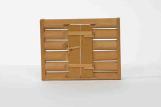14
SACK OF GRAINA large sack of milled grain sits waiting transport to the horse and wagon that would haul the same to the merchant or to the farm home. These sacks were tied originally with strips of bark and made of a burlap type weave.
16
PIONEER DOOR HINGEThis model shows the ingenuity in constructing door hinges entirely of wood. In the book the "History of Wood" the construction of the hinges was detailed. "… The most ingenious parts of the construction however were the hinges. Iron hinges he had not, and could not get. With the auger he bored a hole through the end of a square piece of wood, and the sharpening the other end with his axe he then bored a hole into one of the logs of the house, constituting in part a door-jam and drove the piece of wood into this hole. This formed the top part of the hinge and the bottom part was fashioned in exactly the same way. Now, to the door; in like manner, he fastened two pieces of wood with holes bored through their ends. Placing the ends of the hinges above one another they presented the four ends with holes leading through them, the one above the other. Next he made a long pin with his handy jack-knife, leaving a run at one end of it, and making it long enough to reach from the top of the lower hinge. Through the holes at the ends of the hinge this long pin was placed, and thus the door was hung."
18
THE POST SWING GATEThe McCrea collection contains a number of types of fences several of which are portrayed in the U.E.L. collection. As written in the "History of Wood" - "The post swing gate belongs to the wooden age of Old Ontario. It was made by the pioneer with an axe and an auger, and was easy to operate. It would open both ways, would stay where put and would not slam in the wind. It was durable, did not sag or warp and was horse high, bull strong and pig tight. What more could be asked of a gate?"
20
THE SPLIT RAIL FENCEProbably the most common and popular fence to be constructed by the early settlers, this fence could be built as shown in the illustration or could be zig-zagged back and forth. The construction method was simple and cut cedars which were readily available were used. These fences can still be seen today, marking out the boundaries of the old settled parcels of land. They were durable.
22
THE RAIL SNAKE FENCEIn constructing this version of the fence, a cap or piece of wood was placed under the top rail. This steadied the structure and added height. The bottom of the fence posts was set on a log, usually flattened, which was at right angles to the fence, and which helped reduce the fences sinking in to the ground.
24
SAW MILL - HEWING LUMBERAll pioneer communities and settlements required a sawmill in the vicinity. Hewing timbers from logs was a long and tiresome procedure however the hardy saw mill operators became proficient at their craft and turned out timbers for use in the construction of the dwellings and structures of the community. The model depicts a man hewing lumber with a broad axe. The logs had to first have the bark removed and then sized down to a "square" or hewn shape. Hand hewn logs formed the framework for barns and have lasted for over 200 years in many parts of the province.
26
SAW MILL PITBefore the day of the proximity of the saw mill, a saw pit was a great advantage to the pioneer. In the old countries a pit was dug, but in Canada a bank was usually utilized. Both round and hewn logs were sawn into boards which were needed to build a saw or grist mill or to finish a log house.
Before the sawing started, a line was struck along the middle of the log. The thickness of the lumber was measured from it and the other lines struck. The log was then turned upside down and the upper side lined to match the lower side. It was then placed on a skid and a roller over the opening in the platform. The first cut was made on the middle line as far as the skid. The rest of the cuts alternated outwards from the first one. The skid was then moved to the forward end and the sawing resumed. When the sawn boards began to vibrate they were bound with a chain or a rope to keep the log steady. If the saw bound, wedges were used to let it run free. Before the sawing was completed, the log had to be moved forward one or more times. The log pictured made 250 square feet of 1 in. lumber and represented one day's sawing.
Trestles and planks were used for the top sawyer to stand on when needed. A can for oil or grease for the saw and a club for tightening or loosening the wedge in the lower saw handle, or box, as it was called, were handy. The box had to be taken off each time the saw was moved to the next cut. At the right is pictured a brass model showing the exact size and shape of the pitsaw blade which may be confused with the pitsaw, is also show at right. Pg. 25 - History in Wood






